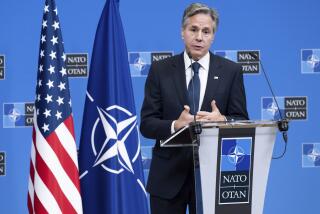From Star Wars to Trade Wars
The climate of international relations is shifting dramatically. From World War II until very recently, the primary focus has been on the military confrontation between the United States and the Soviet Union.
The United States established and maintained the North Atlantic Treaty Organization and provided a defense umbrella over Japan, parts of the Middle East and many other areas in order to keep the Soviets at bay. Many dictators in developing countries were propped up lest those countries fall into Communist hands.
On their side, the Soviets maintained the Warsaw Pact as a military buffer between the Soviet Union and the West and installed and nurtured Communist regimes in such diverse places as Angola, Cuba, Grenada, Afghanistan and Nicaragua.
Furthermore, in the postwar era, the United States and the Soviet Union have been competing to sell their respective economic systems to the rest of the world. The U.S. approach emphasized free markets and very limited centralized control. In contrast, the Soviet economic system espoused tight central planning.
Now, however, the U.S.-Soviet military competition is fading rapidly. Now that the Soviets have achieved nuclear parity with the United States, a balance of terror makes an all-out nuclear arms race less attractive to both sides. Furthermore, the United States has decided that it can no longer afford exploding military budgets.
True, the huge buildup of the early Reagan years did help convince Moscow that the United States could and would outspend it militarily. But with today’s U.S. budget deficit problems, further surges in defense spending come at the expense of domestic programs that are near and dear to the hearts of many voters.
Meanwhile, the faltering Soviet economy, rising consumer expectations, gross inefficiency in industry, widespread alcoholism and other signs of malaise and low morale have convinced Mikhail Gorbachev that an immense shift of resources is needed away from the military and toward building the Soviet economy.
Not only is the U.S.-Soviet military confrontation fading but the war to sell their respective economic systems to the rest of the world is over--the United States has won. Virtually every country in the world has either embraced or is moving toward the U.S. free market system, even China and the Soviet Union itself. In fact, the United States has almost succeeded too well in convincing the rest of the world to become efficient free marketers. It has spawned fierce competitors such as Japan, South Korea, Taiwan and the other Asian newly industrialized countries, known as NICs.
Just as the U.S.-Soviet rivalry is receding, another is rising to take its place--intense and probably protectionist commercial competition among three trade blocs: the European Community, North America and the Pacific Rim countries.
The European Community plans to remove virtually all remaining trade barriers by 1992 and create a 320-million-person market where goods and services can move freely and achieve economies of scale. The result will be a more self-sufficient and inward-looking economic bloc. Examples abound of the EC’s desire to reserve that market for EC-based companies or at least firms that are producing there. When imported Japanese copiers virtually took over the European market, the EC reacted with quotas. Then, when the Japanese sent copier parts to Europe and assembled them there in “screwdriver” plants, the EC put quotas on imported parts.
After 1992, the European Community is likely to erect a common trade policy toward the rest of the world that may well be protectionist even in non-high-tech areas. Already there is talk of a 10% Communitywide auto import quota to keep Japanese cars out, replacing current national restrictions that range from no quotas in West Germany to Italy’s restriction of Japanese auto imports to less than 1% of the market.
North America is also moving toward trade bloc status with the U.S.-Canada free trade agreement, which will remove most trade barriers by 1999. Canada has yet to approve the agreement, but the Progressive Conservative Party’s victory in the recent parliamentary elections, which were a virtual referendum for the trade pact, makes its passage a good bet.
Japan and the Pacific Rim NICs are increasingly alarmed over European protectionism, and U.S. markets may also be closing toward them. The semi-official U.S. trade policy toward Asia is reciprocity--if those countries don’t take a lot more U.S. imports, the United States will restrict imports from them. But by nature, those countries are producers, savers and exporters, not importers of finished goods and consumers, so meeting the U.S. demands will be difficult.
As export markets in the European Community and North American trade blocs close to them, the Pacific Rim countries will have little choice but to band together to capture what export opportunities remain open. A Pacific Rim trade bloc, led by Japan, may be in the offing.
It appears, then, that the focus of international relations is shifting from U.S.-Soviet military competition to intense competition among three powerful trade blocs that may be increasingly protectionist.
Incoming President George Bush and the new Congress will need to understand thoroughly--and as quickly as possible--the profound shift in international relations in order to help the United States and its allies adapt to the new reality. Is it any longer appropriate, for example, for the United States to provide the defense umbrella over Japan, a strong competitor in the new order of things? And against whom, in fact, is the United States now defending Japan?
More to Read
Sign up for Essential California
The most important California stories and recommendations in your inbox every morning.
You may occasionally receive promotional content from the Los Angeles Times.










